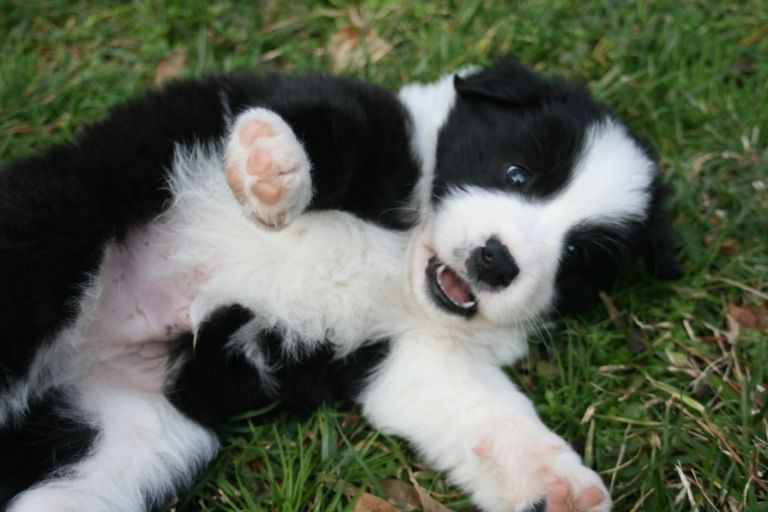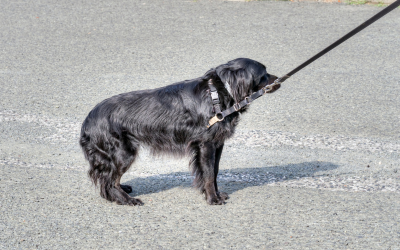congratulations on your new puppy!
Puppyhood is an exciting time full of sweet puppy snuggles and surprising lessons on loss, specifically the loss of sleep, your favorite rug, shoes (so many shoes) and the leg of the antique armoire your dear Aunt Estelle left to you. But do those things really matter? Just look at those sweet puppy eyes, that rolly-polly ball of fluff with a tiny, wagging tail.
Now go snuggle your baby crocodile.
Oh, she’s going for your arm? What a surprise.
I have some bad news for you and your Aunt Estelle. There’s no magic fix that will stop your puppy from biting. There are loads of recommendations out there on the internet but the most helpful tidbit you will find is: It ends, eventually. Puppies will be puppies, afterall.
Alas, we have some solutions! With a little management and training, curbing puppy shark mouth is possible!
Manage the environment.
Think of it like having a toddler in your home. Same, really. You will need to puppy-proof the house. Shoes, books, bags, pillows, paper items, and articles of clothing must be kept off the floor at all times. Nothing is safe. Anything even remotely interesting that is left within reach will likely be shredded. Consider yourself warned!
If your puppy has a taste for wooden table legs, sheetrock (mmm), or other things that can’t be placed out of reach, you have a few options. You can use a baby gate or other barrier to block her access to areas where these things are. You could apply a deterrent spray to items such as power cords. It’s nontoxic but it tastes terrible to most (but not all!) dogs. A word of caution that it tends to end up everywhere so expect to get a taste too. It’s nasty stuff for both humans and dogs. Blech.
What’s the function of the behavior?
When we see behavior as having a function, we stop seeing it as misbehaving. This makes it a bit easier to live with your piranha puppy.
Puppies have a hard-wired need to bite and chew on things. They use their mouths to explore the world around them. And they don’t yet have the skills (or feedback) to tell them what is appropriate. They don’t get a manual so they need to be gently guided.
Puppies are teething from around 16 weeks up to the age of 7 to 8 months, when your puppy should have all 48 of her teeth (fun fact: that’s 10 more than humans have).
It is normal for puppies to use their mouths when playing with each other. It’s only a painful concern when human hands and family heirlooms get in the mix. At a very young age, puppies learn how much pressure with their mouths is too much from the feedback of their littermates and their poor tired, gnawed-upon mama. The puppy learns bite inhibition through these early interactions when allowed to remain with her litter until about 8 weeks. This is an important lesson that teaches the puppy what to do with their teeth so they don’t get in trouble with them later.
What can your puppy chew on instead of the armoire or your toe?
Well, that depends on your puppy. Dogs have their own preferences about what they enjoy so it may take some trial and error to find what works for your pup. I suggest having lots of different types on hand:
- Softer chews specifically designed for puppies without adult teeth
- A knotted frozen washcloth can help soothe sore teeth and gums
- Long rope or fleece toys for tugging
- Plush squeaky toys for biting and carrying
- Toys or balls for chasing or fetching
- Sturdy interactive toys for enrichment
- PetMate chew toys
- KONG puppy toys
- Nylabone puppy toys
Be sure to check your local independently-owned pet supply store for recommendations of the best items for your puppy’s needs.
Whatever you reward, you will get more of!
Puppies are tiny sponges and will quickly figure out what works! They just don’t have a lot of impulse control. Here’s how to help them learn it:
Play with your puppy and get to know what she likes. This is a great way to bond with your dog and will also help break the habit of mouthing.
If your puppy bites, get up and walk away for a very short time (10-20 seconds). You may need to return pup to a pen or crate.
Once your pup is calm you may resume play.
If she mouths again, repeat above. If she keeps her teeth to herself, the game continues.
Keep appropriate toys close by anytime you’re playing with your pup. You are transforming a mouthing puppy into a dog that is playing with you through the toy and rewarding nice play with more play. Reward anything that isn’t biting with more play.
Be careful to redirect to toys before she bites. If your puppy bites you and you immediately reach for her favorite toy and start playing, what was the behavior that got you to play? What did your puppy just learn? (whispers “biting”)
If teeth get out of control game is over for a moment.
Notes
Avoid playing roughly with your puppy. Encouraging rough play results in a mouthy dog with no “off switch.”
No teasing with your hands or fingers, or engaging in an impromptu game of tug with a shirt sleeve or sock. Keep a toy in your hands during playtime.
Physical corrections can create a puppy who is fearful as well as damage the bond you are working hard to create with your new puppy. Fear is a major contributor to dog bites and can lead to aggression in older dogs.
Do not just tell your puppy “no” when she is mouthing on you. Any attention, even negative, is still attention. Consequences drive behavior; get up and walk away instead.
Yelping when the puppy bites you is not a real solution. Why? 1) You’re not a dog and you don’t speak dog. 2) It can be scary or exciting or plain old confusing. Just let your actions speak for you and stop the play.
Respect and gentle handling for all dogs!
If you’re trying to pet or snuggle your puppy and she bites you, calmly stop petting and ignore her until she calms down. If your pup is particularly excitable and mouthy, you may find that there is a time of day when she is sleepy or more open to snuggles. And that’s ok! Petting may be over-stimulating for her sometimes so just wait until she’s ready.
While it’s important to be mindful of how you approach and attempt to touch a dog of any size, respect and gentle handling for puppies is essential. Humans are so grabby. We love to pick up puppies. Imagine just going about your own business, and suddenly you’re being swooped off your feet and up, into the air then held without your consent. I would use my teeth too!
Be patient and consistent.
When it comes to training dogs, progress is not always linear.
You may have lots of baby shark days before you see results. As long as you don’t do anything to reinforce the behavior, it will get better over time. How long it will take depends on the tenacity of your puppy.
Oh, and expect a second chewing phase at around 6-9 months- now with a bigger and stronger mouth!
But you already know how to handle it.
You got this!



